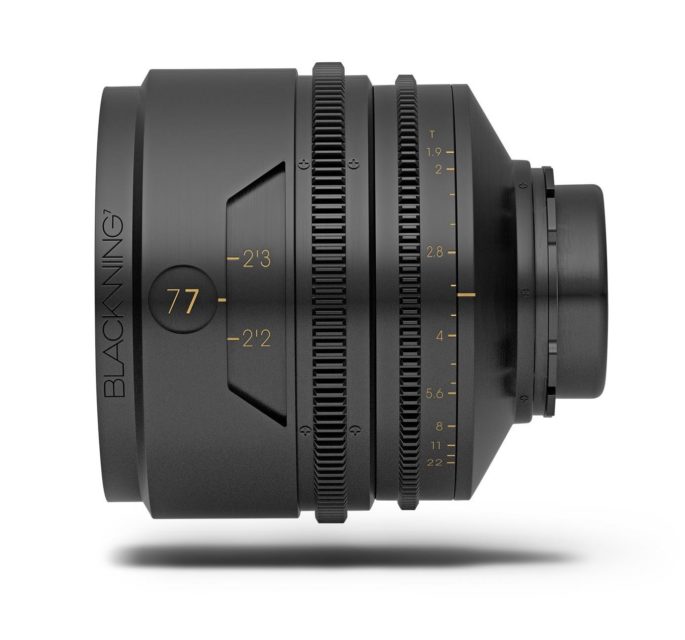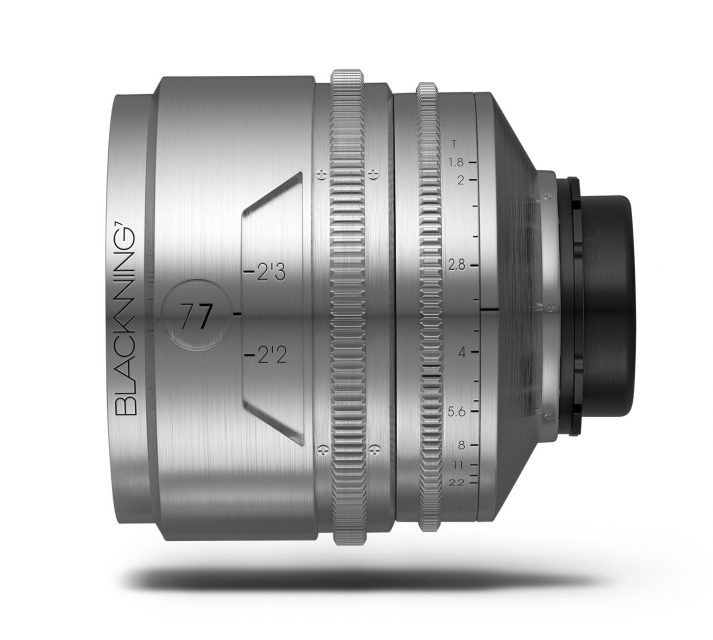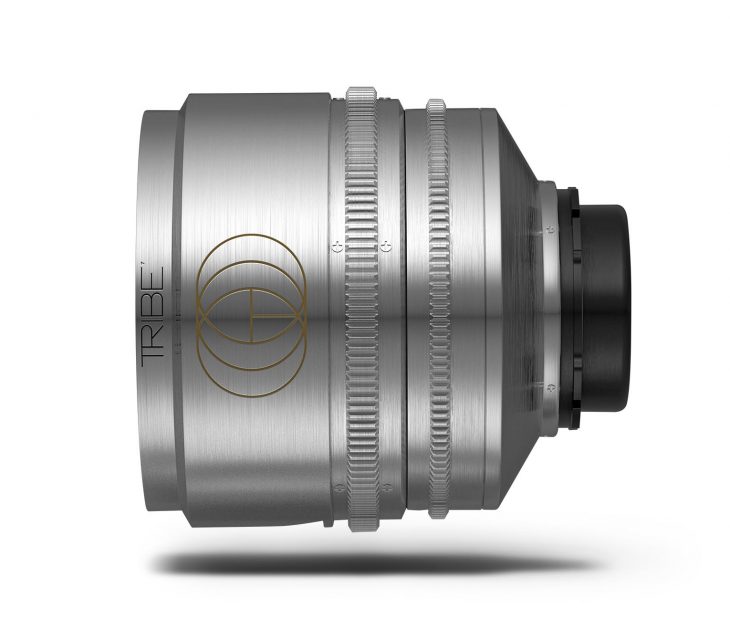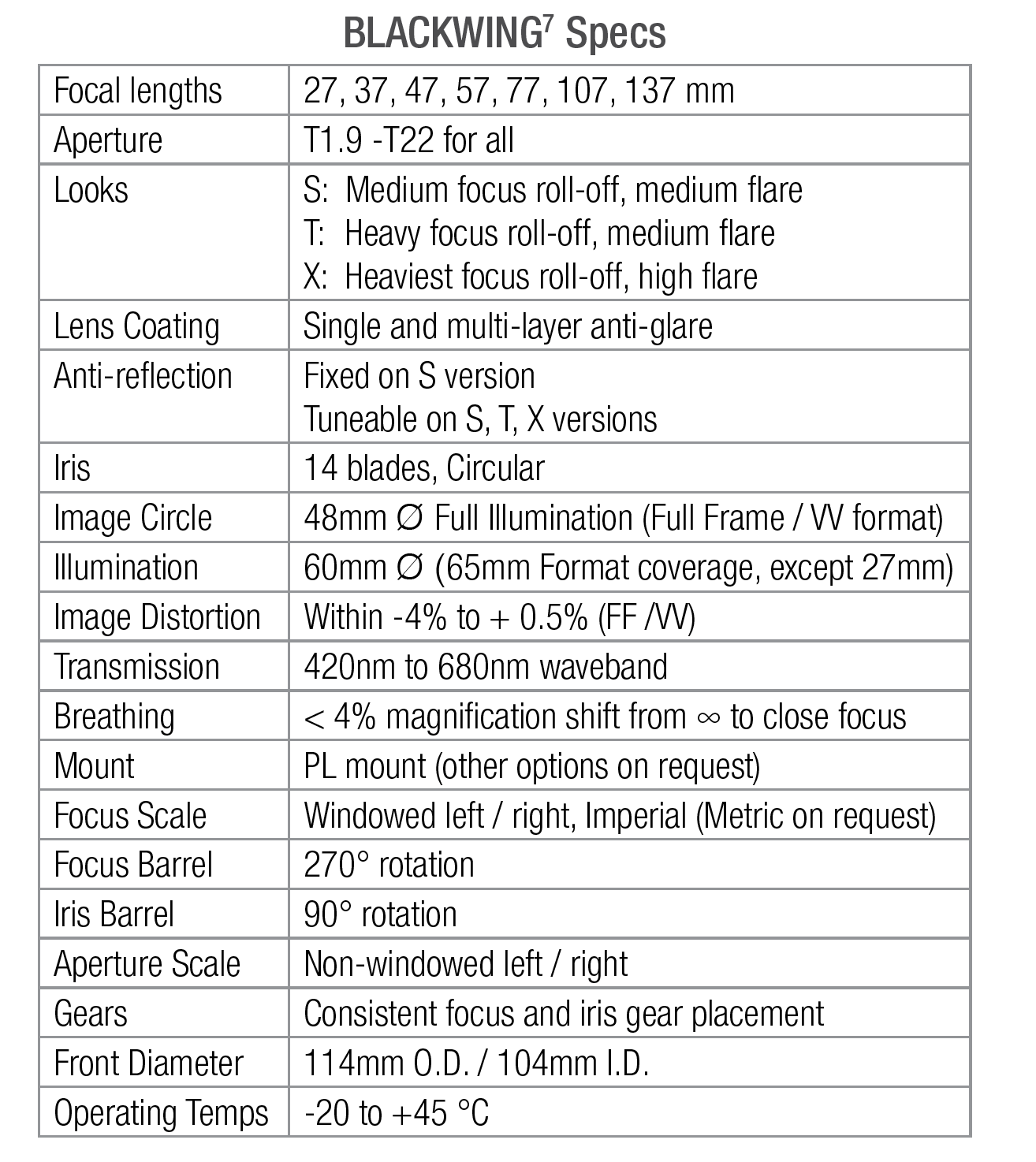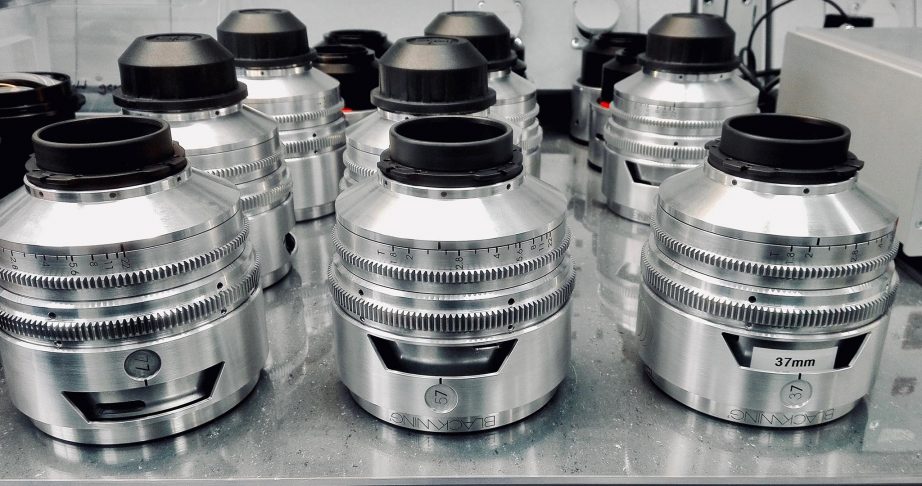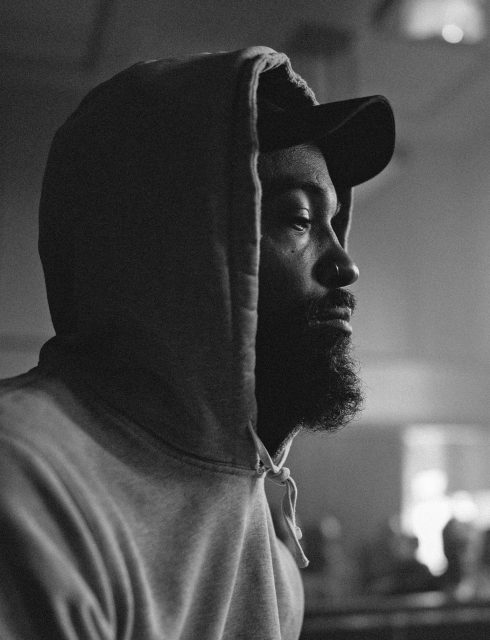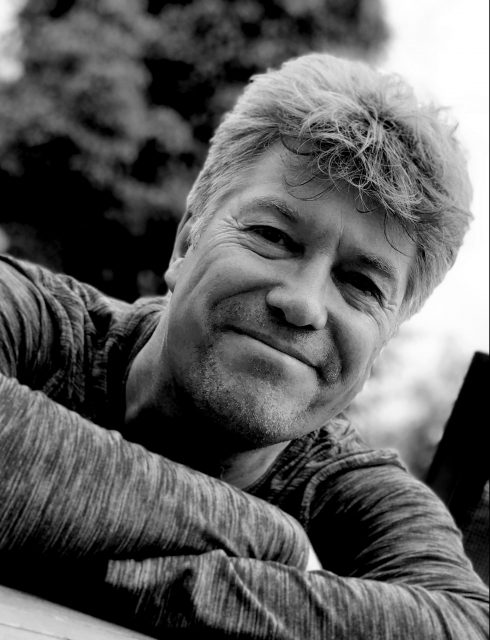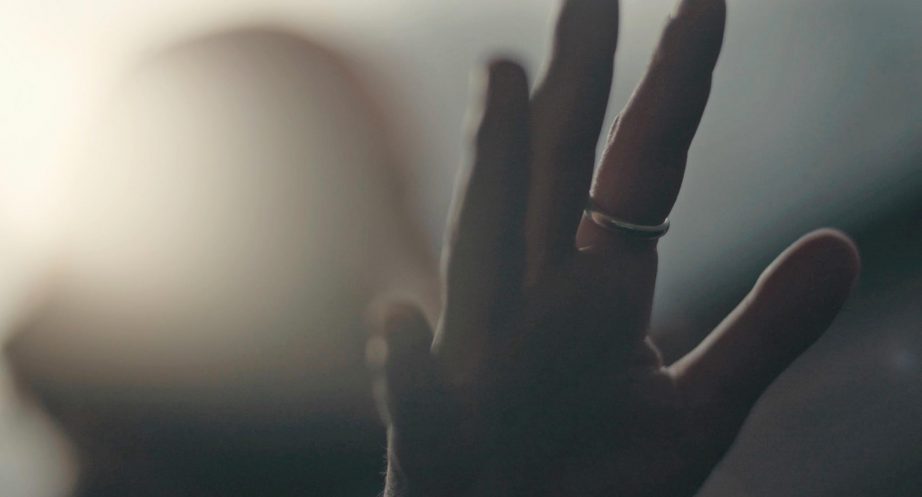- Black BLACKWING7
- Brushed Aluminum BLACKWING7 Binary
- Top view
BLACKWING7 Primes
Tuneable optics. Seven focal lengths in the initial set. A choice of 3 looks. Custom tuning by design and by appointment.
BLACKWING7 prime lenses will be available to order exclusively from TRIBE7 beginning March 2019, with production deliveries starting in Summer 2019. Additional focal lengths—including wide angle, macro, close focus and faster T-stop versions—will be developed during late 2019 and ship in 2020.
BLACKWING7 binaries
Ten sets of first-edition lenses will ship from March 2019 to select clients: initially 37, 57 and 77 mm, with the rest delivering by September 2019. The BLACKWING7 binaries are slightly faster at T1.8, but have the same response and overall image qualities as final production lenses. The housings have a polished aluminium finish. They have T-tuned characteristics with exaggerated flaring because of selective lens element coating.
Looks & Pricing
S-tuned BLACKWING7 lenses begin at US$ 10,000 each. 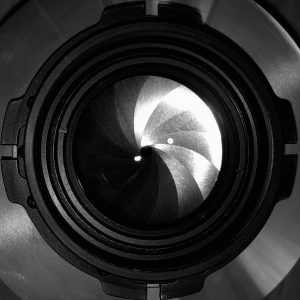
T and X BLACKWING7 are between US
$10,770-11,700 each.
BLACKWING7 binaries are about US$ 12,700 per lens.
These prices are preliminary and may change. Individual custom lens tuning and personalization services are available on request and will be priced accordingly.
Contact: 7isatribe.com
BLACKWING7 Backstory
- Bradford Young, ASC
- Neil Fanthom
Neil Fanthom and Bradford Young ASC have launched a new company called TRIBE7 and a new series of Large Format lenses called BLACKWING7. Focal lengths so far are: 27, 37, 47, 57, 77, 107, 137mm. Lots of sevens.
Neil Fanthom was one of the ARRI Rental gentlemen who whisked me off to an undisclosed NDA location at NAB in April 2013, exactly 6 years ago, to foreshadow what would become the ARRI ALEXA 65 and its creative collection of characterful lenses. One year shy of seven years later, Neil and Bradford launch BLACKWING7.
Bradford Young, ASC is the acclaimed cinematographer whose credits include Selma, A Most Violent Year; Arrival; and Solo: A Star Wars Story. He studied film at Howard University. Bradford’s cinematography on Arrival won a Silver Frog Award at Camerimage and nominations from the Academy, BAFTA and the ASC.
Clearly, these gentlemen know about lenses and look and cinematography.
Neil explained, “TRIBE7 is a company interested in all aspects of creative image making and especially in color science, light and optics—how those facets of imaging can be explored, and re-imagined, to the benefit of today’s creative filmmakers. One of our aims is to provide artists the ability to tune (enhance) and de-tune (distort) elements of color and light to bring a greater intentionality and visual authority to their story.”
Bradford added, “It has been an interesting journey. It all began when I was researching cameras and lenses for Solo: A Star Wars Story. Neil came to me with a wonderful opportunity to experiment. They were developing the DNA lenses at ARRI Rental and that gave me an opportunity to embed some of my own meta, my history and some of my own life into the glass. Things progressed from there and now we are introducing BLACKWING7.”
The new BLACKWING7 lenses are Large Format T1.9 tuneable lenses based on designs from the early 20th century. There are 3 sets of lenses with varying degrees of “distress,” distortion and look. Additionally, they can be tuned-to-order to the taste of the individual cinematographer. The optical design allows for the flexibility to provide varying degrees of spherical aberration, halation, and flare. This offers varying degrees of smoothness to the in-focus image area, different amounts of focus roll off in the out-of-focus areas, and unique flare characteristics.
Each focal length in the set has three variations: S (Straight), T (Transient) and X (Extreme). The lenses have been designed from the ground up with subtle distortions and edge halation that is generally seen with 1930-1950s lenses. The halation can give the lenses a look that’s even faster than the native T1.9 because it lowers contrast, fills in the shadows and accentuates the focus roll-off on faces and objects.
The first focal lengths out of the gate will be 37, 57 and 77mm. The additional four focal lengths, 27, 47, 107 and 137 mm will be delivered next. A 17mm and additional focal lengths may come later.
From the beginning of our discussions about this new venture, Neil made frequent references to music. He pointed out that just as cinematographers are constantly seeking unique visuals that differentiate their work, so do musicians modify their instruments and tune the acoustics.
BLACKWING7 tuning
Every BLACKWING7 lens is hand-built in Germany in cooperation with a long-established and well-respected optical manufacturing firm. A proprietary production tuning process allows the optical performance of each lens in the range to be uniquely configured—tuned or toned— to their owner’s wishes and creative style. Three pre-set tonalities are available:
S STRAIGHT (Standard)
S-tuned BLACKWING7 lenses have a profile founded on lens designs from the first half of the 20th Century, such as the 1936 Kodak EKTAR 45 mm f/2, and the 1950 Wray UNILITE 50 mm f/2. Lenses have a simple one-layer coating and a smooth roll-off to their sharpness characteristic.
T TRANSIENT (Middle)
T-tuned BLACKWING7 lenses have a profile which further softens the roll-off to the edge of the frame, and provides increased edge detail halation. T lenses are designed to capture a slightly softer, artistic image, with a higher degree of light reactivity and flaring characteristics are harder and more prominent than with the S-tuned version.
X EXPRESSIVE (Extreme)
X-tuned BLACKWING7 lenses exaggerate the image roll-off to the edge of the frame, to the point where only low frequency performance is evident in the outer thirds of the frame. X-tuned optics have further exaggerated edge detail halation and a minor degree of spherical aberration and focal plane curvature, which exaggerates the effect of shallow depth of field. X-tuned lenses are designed for filmmakers who light aggressively and expect their lenses to offer luminous characteristics, especially with hard lighting.
Bradford Young, ASC
Bradford Young, ASC continued the discussion on how BLACKWING7 began, “During prep on Solo: A Star Wars Story, I was excited about what was happening with the DNA glass. We kept testing and pushing hard. Then, I got a call from Neil one day as I was testing ‘donor’ lenses with the whole camera crew and looking at flares, uncoated glass, compression, fall-off and chromatic aberration.
“Neil had a lens that he wanted us to take a look at. It was a vintage 50mm T2.0 that he’d sourced, but which was proving tricky to rehouse. The optical groups were in a jury-rigged rehousing and we had to be very gentle with it. I don’t mean to exaggerate, but when we mounted it on the camera, it was one of the best looking lenses I’ve ever seen. It had so much going on— so many imperfections that were really strange.
“There was a beautiful roll-off distortion. The inside of the barrel hadn’t been anodized so it was getting a strange flare that I hadn’t seen before. It was gorgeous portraiture glass. We pushed to make the look more ‘dirty,’ more atmospheric, less clean. As the DNA project progressed, I could choose each lens for different scenarios in a different way.
“Once we started shooting, Neil would pop in every now and then. One day, in 2017, we got to talking about the future. I said that I love shooting, I love being on set. But I come from a family of teachers. I always thought I’d be a good supporter. I like to stand next to other cinematographers and hear what they have to say about the craft, the art form. I’d love to pursue something additional in my life and provide a service for my colleagues.
“The next day, Neil comes to set again and asks, ‘Do you have a moment? Can I talk to you about something?’ We walked off set and settled to talk, of all places, next to a dumpster in the middle of Pinewood.
“He said, ‘I’ve been thinking about what you said yesterday. I love filmmaking. I love the art. And I’m also a scientist and I have seen how you cinematographers really want customized lenses that are unique and have personality.’
“Neil described a concept that addressed the needs of Full Frame, high resolution acquisition.
“The dilemma for everybody at the time was that producers wanted us to capture more resolution in Full Frame / VistaVision formats, but there was not enough lens support. I totally did not understand that concept before Neil pulled me outside. I had skipped from Super35 to Alexa 65. And I had not paid attention to anything in between.
“I get it now. That was the reason why the Full Frame cameras and lenses started coming out. Neil explained that he was not thinking of sculpting glass to replicate the old formulas, which were essentially ZEISS lenses from the 1930s to 1960s.
“He wasn’t trying to write an algorithm on how to grind the glass exactly the way they did then. Instead, he wanted to take current technology and use those biases that we liked to give a new series of lenses a certain kind of character.
“This was very interesting because I could see why many people were yearning for such a lens series. This would be a new opportunity for us to introduce a new normal, not a sub-culture perspective to glass.”
Neil Fanthom
Neil explained, “BLACKWING7 lenses are crafted though a process of innovation and intention. The lenses exhibit unique imaging properties that arise from the introduction of distortion during the development and manufacturing processes. This distortion is modular by design and allows control over key parameters that shape many creative characteristics of the lenses.
“The range comprises a core set of 7 focal lengths, with each lens having tuneable optical qualities. BLACKWING7 lens tuning allows parameters such as sharpness, contrast roll-off, spherical aberration, field curvature and edge halation to be modified. This level of tuneability can be applied to the entire set of lenses, or on a lens by lens basis, to create curated optics that suit the personality and intent of the owner. In concept, the ability to individually tune each BLACKWING7 lens is identical to how EQ adjusting is used in music production—to control the range, or shape of tonality in specific wavelengths across the audio frequency spectrum.
“Many of the design cues for the BLACKWING7 series are founded on vintage lenses, but the real inspiration for our tuneable optics lies in the experimental nature of jazz music. The resulting image from a tuned BLACKWING7 lens can be described as having an artistic, musical fidelity to it.
“The aesthetic design of the lenses is minimalistic yet purposeful and ergonomic. Focus and iris gearing placement is consistent across all focal lengths, scale rotation is smooth, and the lens casings are robust. BLACKWING7 optics will provide years of dedicated service.
“The set is designed to fully cover Super35 and Full Frame formats, with all but the widest BLACKWING7 lens illuminating the 65mm format. Lenses exhibit good close-focus performance. They will fit onto both film and digital PL mounted cameras and are uniformly rated at T1.9 across the range.
“Unique and uncomplicated lens element coatings produce a variety of flare characteristics, ranging from the subtle to the exaggerated. Pricing will appeal to individuals and rentals alike. Due to the tuneable nature of BLACKWING7 lenses, availability is strictly through advance order placement.”
Reprinted from Film and Digital Times April 2019 Edition #93-94

